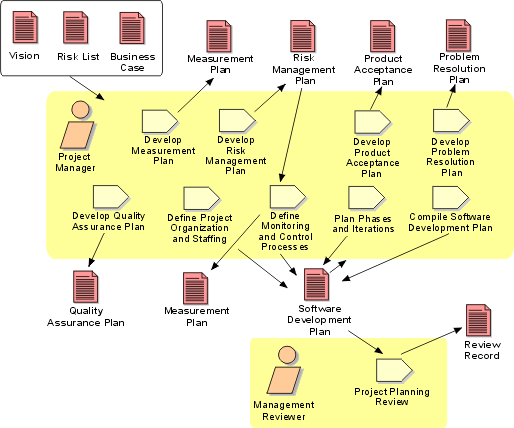Workflow Detail: Plan the Project
|
The purpose of this workflow detail is to develop the components and enclosures of the Software Development Plan, and then have them formally reviewed, for feasibility and acceptability to stakeholders, and as the basis for the fine-grained plan for the next iteration (the Iteration Plan). |
|
|
|
Description

The major effort in creating these artifacts comes early in the inception phase; thereafter, when this workflow detail is invoked at the beginning of each iteration, it is to revise the Software Development Plan (and its enclosures) on the basis of the previous iteration's experience and the Iteration Plan for the next. The Project Manager will also collate all other contributions to the Software Development Plan and assemble them in Activity: Compile Software Development Plan.
Related Information 
This section provides links to additional information related to this workflow detail.
Timing 
The major effort occurs early in the inception phase; thereafter, at the beginning of each iteration.
Optionality 
This workflow detail is recommended.
How to Staff

This workflow detail will obviously stress the Project Manager's estimation, planning and writing skills. Also, the Project Manager must ensure buy-in from affected stakeholders during the construction of these plans, so presentation and communication skills will also be important. The Management Reviewer will need to be experienced in the estimation of projects in the relevant business or technical domain and should be able to make judgments about the validity of assumptions made by the Project Manager. The Management Reviewer should also have enough understanding of the Rational Unified Process to judge whether the Development Case is accurately represented in the Software Development Plan.
Work Guidelines

Estimation should ideally be based in the organization's own experience,
which is then used to calibrate an estimation model, such as COCOMO. (See [BOE81]
for a description of the original model, or go to  http://sunset.usc.edu/research/cocomosuite/index.html
for the latest work.) If the Project Manager is starting from scratch, using
default values for model coefficients, it will be important to use other methods
to validate the estimates. Just as important is to obtain staff and other
stakeholder agreement that the estimates are realistic and achievable. However,
the Project Manager has to take into account the experience of staff giving
feedback about estimates. More junior staff may be just guessing numbers and
then adding large margins for error; conversely, their effort estimates may be
naively low. The Project Manager must be circumspect when dealing with estimates
from junior staff, and be prepared to counsel them when necessary, and offer the
assistance of a more experienced peer. See Activity:
Plan Phases and Iterations for more information about estimation.
http://sunset.usc.edu/research/cocomosuite/index.html
for the latest work.) If the Project Manager is starting from scratch, using
default values for model coefficients, it will be important to use other methods
to validate the estimates. Just as important is to obtain staff and other
stakeholder agreement that the estimates are realistic and achievable. However,
the Project Manager has to take into account the experience of staff giving
feedback about estimates. More junior staff may be just guessing numbers and
then adding large margins for error; conversely, their effort estimates may be
naively low. The Project Manager must be circumspect when dealing with estimates
from junior staff, and be prepared to counsel them when necessary, and offer the
assistance of a more experienced peer. See Activity:
Plan Phases and Iterations for more information about estimation.
All enclosed plans and sections of the Software Development Plan should be evaluated through internal walkthroughs and reviews before the Project Planning Review occurs.

